Introduction
This guide is an attempt to create a reference for those who need to identify and authenticate Python grips, but it’s by no means the definitive “be all end all” guide, at least not yet. It’s a work in progress that will be updated as more info is found, and our hope is that knowledgeable collectors will help us clarify the info, fill us in on omissions, correct our mistakes and eventually make it complete.
It’s based on a compilation of information and pictures gathered from various Colt Forum members and forum discussions, so to to those who participated in this: You know who you are and your contributions are greatly appreciated! We have also added some of our own pictures and observations.
The Python target grips are often referred to as “the 3 generations”, but that’s only part of the truth. Grips of the same generation will sometimes show more or less pronounced variations and deviations, some are clear design changes while others indicate that Colt used different subcontractors to make them. Some original grips have even been mistakenly identified as aftermarket products due to differences in their appearance, so the purpose of this write-up is to get all known variations gathered in one single document where they are presented in a format that’s easy to follow.
The model years should be fairly correct, but should still be taken as guidelines rather than the absolute truth. There is usually a difference between model year and year of manufacture, and it would also make sense that Colt used up all the grips they had in stock before they started installing a new variation. Whatever the case might be, it would not necessarily be incorrect for a gun to have grips of an earlier type than the date of manufacture indicates.
We have also added some notes and pictures to help you identify the original hardware. Knowing what this is supposed like is often enough to identify an original set of grips.
Any input, corrections or additions to this guide will be greatly appreciated! However, keep in mind that grips and hardware are easily changed and may not be original to your gun. If you want to add information based on your own observations, please verify that your gun does have the original grips in untouched condition!
Hardware
One good way of identifying original Colt grips is to study the hardware. Colt used an easily recognizable screw in all three generations of the target grips, and one characteristic feature is the tall screw head. Also note the rather small #2-64 thread, which makes the shank noticeably larger in diameter than the threaded section. The screws were always installed from the left side, with no escutcheon in the hole.
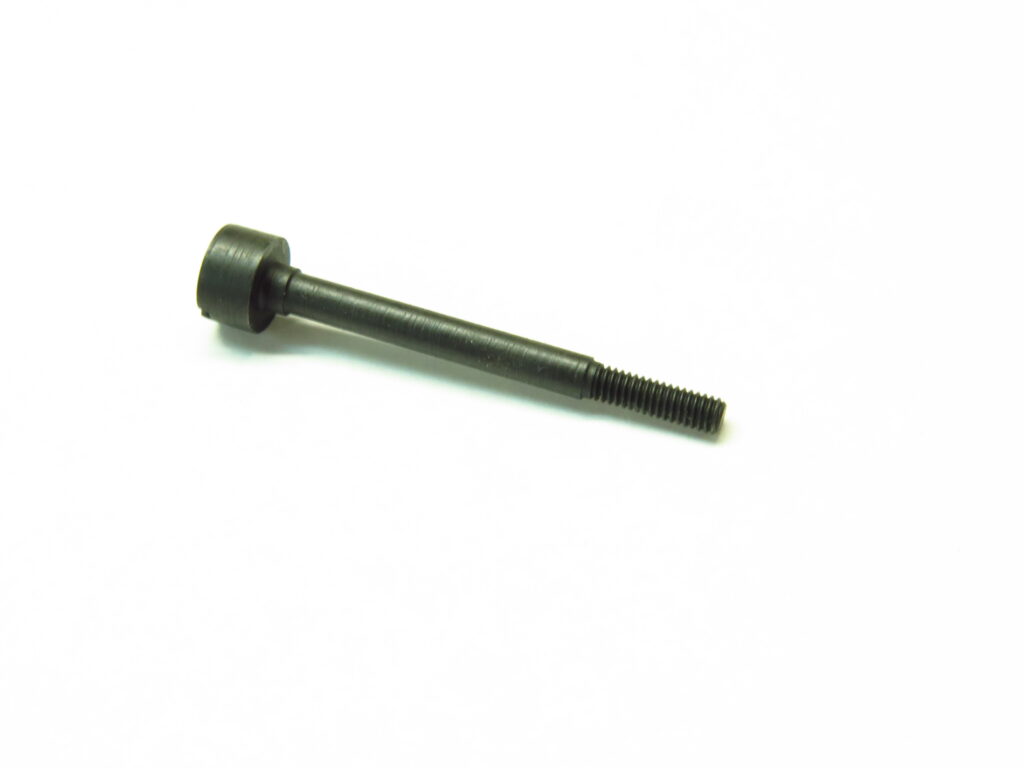
Original Python grip screw. Note the reduced diameter thread and the large head.
Most reproductions use larger diameter screws, often with metric thread and sometimes with an escutcheon for the screw head. You will also find reproductions with screws and nuts made of brass. These details are dead giveaways, as the original grips always had blued or nickel plated hardware and no escutcheons.
The medallions could probably be subject for a separate guide, but some details should be pointed out. First of all, they were always gold colored in the three generations of Python target grips and in the Python service grips. The first two generations and the service grips were also used on other E/I frame guns, these grips were identical to Python grips but had silver medallions. When you find these grips for sale they are usually advertised as Python grips, either because the seller doesn’t know better, or simply because the Python name brings more money. Whatever the reason may be, always check the medallions for color (which can be difficult on badly worn examples) and for signs of a replacement. It doesn’t really matter much if they came off another type of revolver as they are still the same type of grips, but there is no reason to overpay just because they’re advertised as Python grips.
The Colt medallions were always of good quality, while most reproductions show flaws like casting flash, incorrect diameter, uneven edges etc. Also, many reproductions have a “soft” or “blurred” look to them, while Colt medallions are cleanly and crisply made. Most Colt medallions were made of solid brass, but some appear to be made of a white metal (possibly aluminum or zinc) with gold plating. All reproductions we have seen have been made of cast zinc alloy (“pot metal”), with obvious signs of a more or less advanced casting process. The metal is brittle, and will often crack or even fall apart when it’s staked.
Once removed from the grips, you will also find that the stems on original medallions have a knurled section to keep them from turning during the staking process. There is also an early variation with two nubs on the stem (in lieu of the knurling), which we assume is for the same purpose. These are features you rarely see on reproductions, the stems on those are normally entirely cylindrical.
As far as the original variations go, there are some design features that vary with the vintage. However, we have also observed some slight variations in medallions of the same vintage, and (allegedly) newer style medallions appearing on older grips. We find it very unlikely that Colt would go through the trouble of re-designing the medallions just to change such minute details, so we would venture to guess that all these small differences indicate changes of subcontractors, re-tooling or other more practical reasons. The lack of a strict chronological order is another clue that Colt didn’t really care if the medallions were perfectly identical from gun to gun, it looks more like they were used as they came through the door from different subcontractors. This makes it difficult to memorize and identify the original medallions by their actual design and vintage, so it’s much easier to simply go by the overall quality.
The standard medallions show “The Rampant Stallion” standing on top of a globe, but there were also a few special medallions used in very late production. The first one is the “anniversary medallion” (1986 to early 1987), which shows the upper half of the horse with “Colt/150” to the left. The second one is the “post anniversary” medallion (early 1987-1989), which is a similar half horse but without the “150”.
The medallions were staked from the back to keep them in place, and the two methods of staking are described under each generation.
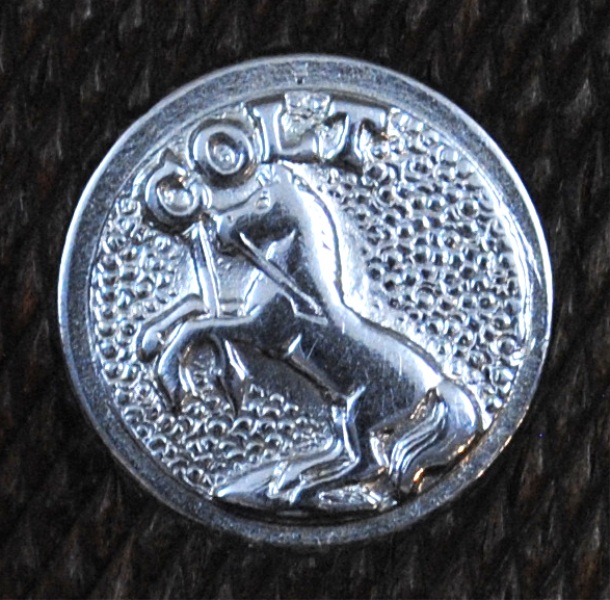
First variation medallion used on the Python target grips. Note the flat edge and the raised artwork. The picture shows the silver variation used on other guns, but is otherwise identical to the gold variation used on Pythons.
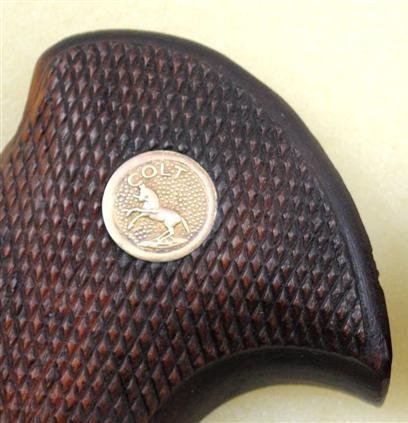
Second variation medallion used on the Python target grips. Note the rounded edge and the recessed artwork.
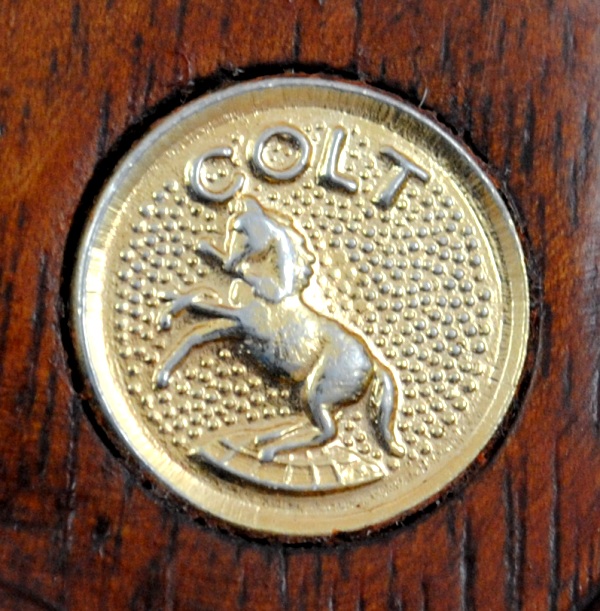
Third variation medallion used on the Python target grips. Note the sharply beveled edge and the recessed artwork. Also note the position of the horse’s head in relation to the “COLT” text. A slightly different variation of this medallion (which is still in production) shows the horse slightly turned, with the head under the “L”.
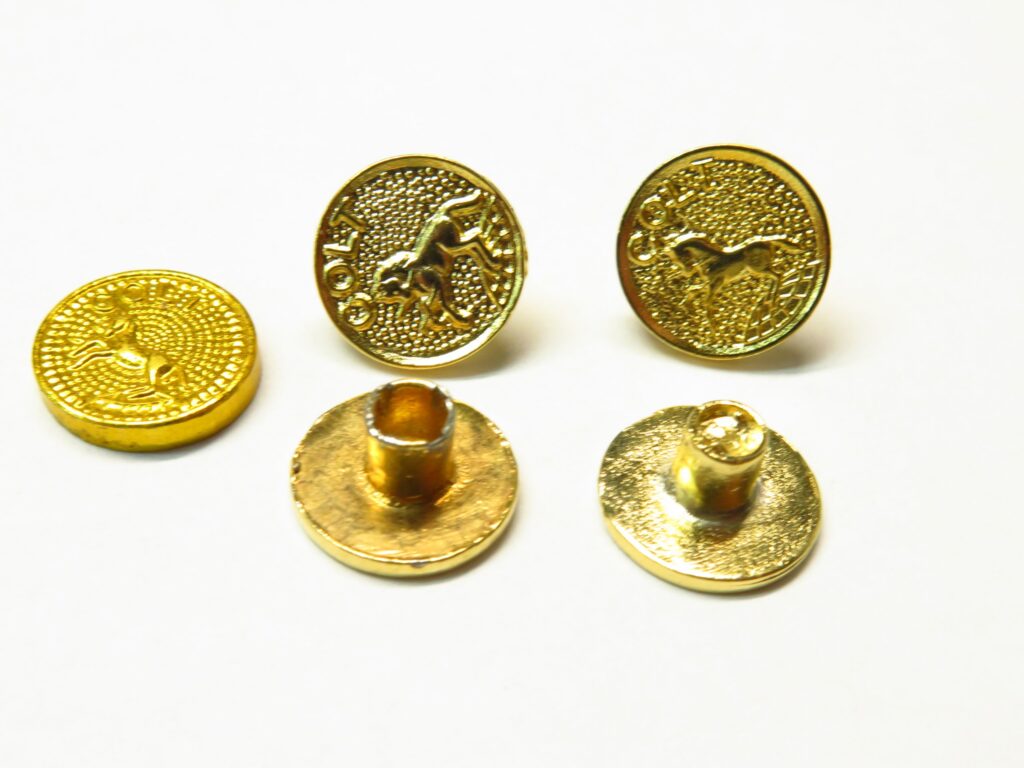
Some reproduction medallions of different origin. The one to the far left is a simple, glue-in type with an odd, concentric pebble pattern. The other ones look fairly good at first glance, but you can still tell that they are cheap castings. The one in the bottom right corner is so poorly cast that the stem is not even hollow. This means that it can’t be staked, and many times you will find these glued in.
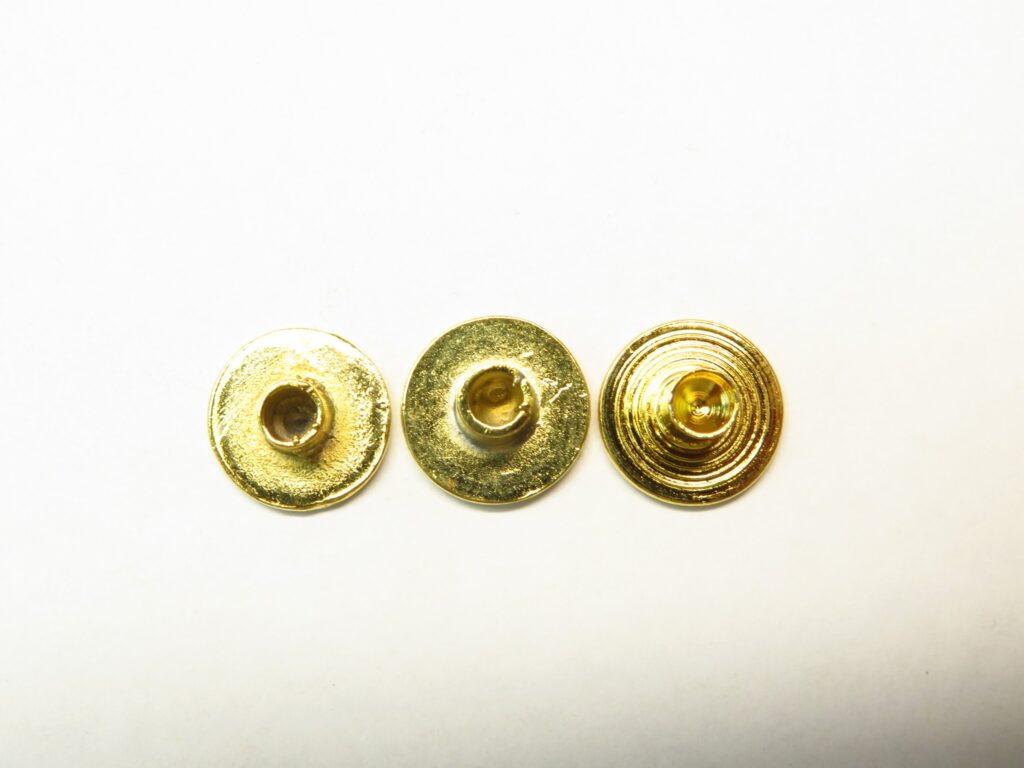
Two reproductions to the left and an original to the right. The difference in diameter is not very noticeable in the picture, but will become obvious once you try to install them. The one to the left is too small and will leave a gap around the perimeter, the one in the center is too large and won’t even fit in the recess.
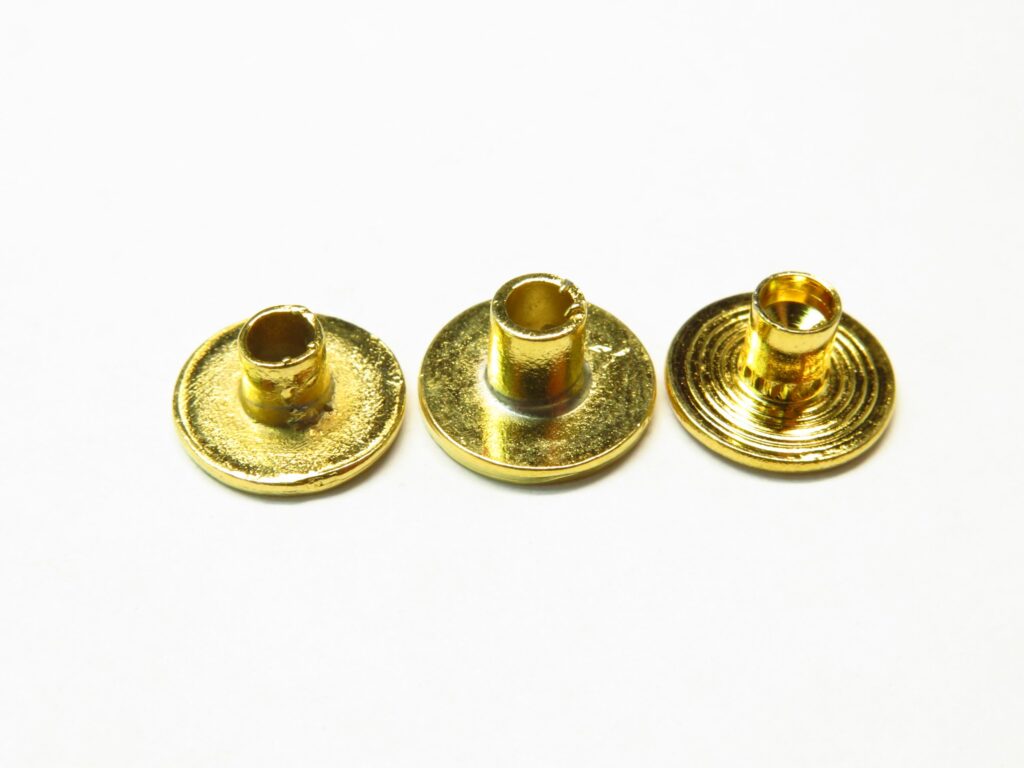
Same medallions from the side, and here you can see the difference in thickness and stem length. Also note the knurled stem section on the original to the right, this is a feature you rarely see on reproductions.
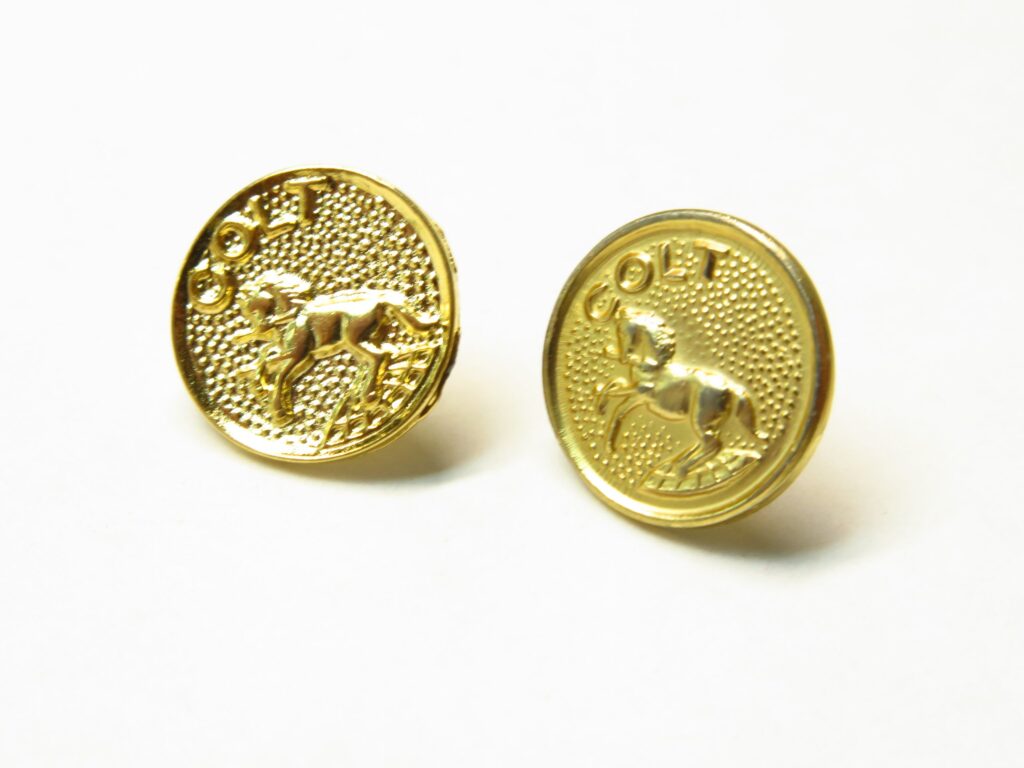
Reproduction to the left, original to the right. Note the somewhat “blurry” appearance of the reproduction, and the jagged casting flash around the edge. What you can’t see in the picture is that the reproduction is about .010”-.015” smaller in diameter, which leaves a noticeable gap around the perimeter when installed. Also note the difference in sheen in these particular medallions. We think it’s safe to say that the original medallions always left the factory with a high sheen, but most of them have a more or less faded look due to their age. A high sheen does not necessarily mean that it’s a reproduction, but it’s a red flag if you find them on older and/or worn grips.
Checkering
The checkering on all 3 generations was cut with a 90 degree V-shaped tool at 16 lpi (lines per inch) and with a consistent angle between the lines. The line pattern was (with a few exceptions observed) also laid out in a consistent angle to the grip panels, although this angle varies between the generations. The cutting was done with a vertically held (or mounted) tool, which is why the lines appear to get wider and fade out when they wrap around the rounded surface. Comparing checkering patterns, line angles and the proportions of the “diamonds” can often be enough to tell if grips are original or not.
Cross section
The cross section (as seen from the bottom) of Gen 1 and Gen 2 is a fairly consistent oval shape, and this was also used on transitional (early) Gen 3. The late and final variation of Gen 3 has more of a compound curve cross section, many times with a nearly flat front strap. The difference is clearly visible when you look at the grips from the bottom. The thickness of the panels remained consistent throughout the generations, even though the late Gen 3 is often described as “fatter” due to its somewhat bulkier shape.
Wood quality and finish
Most of the Python grips were made of walnut, and the quality of the wood declined through the years. Starting with Gen 2, the grips were sprayed with a tinted clear coat to make the color more attractive and uniform. The tint is a translucent “spray stain” that allows the wood grain to show through it, but some Gen 3s will have such a heavy coat that it’s almost opaque. The color of this tint varied between brown and reddish brown, more than likely a sign of the grip manufacturer’s choice of materials.
There are also grips made of mahogany, most common in Gen 2 and transitional Gen 3. This wood is soft, light in color and weight, and has a very plain, “featureless” grain when compared with walnut. These grips can be either clear coated or tinted, and they are easy to identify if you look at the unfinished back of a panel. We haven’t found any pattern in how the wood species were used, so we can only assume that the wood was chosen by the grip manufacturers and not by Colt.
There are also distinctive differences in the quality of the finish. Gen 2 usually has a nice, smooth finish, while late Gen 3 can show a lot of open grain and a less carefully applied finish. We have added a few comments on this under each variation.
Generation 1 (1955 - 1959)
These are easily recognizable, as they are fully checkered with just a thin, smooth border around the perimeter. The backs are either flat, or on later examples cut with the same style fitting pads as on Gen 2. The panels are symmetrical from side to side.
The Gen 1 grips were made of high quality walnut with an oil finish. We have also seen them in a lighter colored wood, possibly mahogany. Most of them have a dark color with a “greasy” sheen, but the mint grips we have seen were a medium brown color with a fairly thin, almost dry looking oil finish. This would indicate that the dark, greasy look is a result of aging and oil, dirt, hand sweat etc. being rubbed into them over the years, and not necessarily representative of what they looked like when new.
The screw heads had a polished finish and were always blued. The medallions were often staked with a pyramid shaped tool, which cut and folded the stem to form four tabs. They may also have the later style conical flare. Some very early grips (1955-1956) have been reported having the stamped sheet metal medallions.
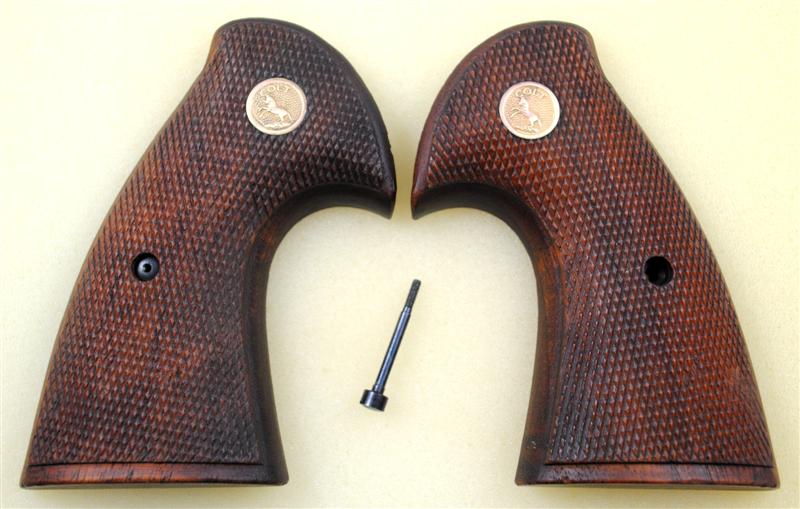
1st gen Python grips, front.
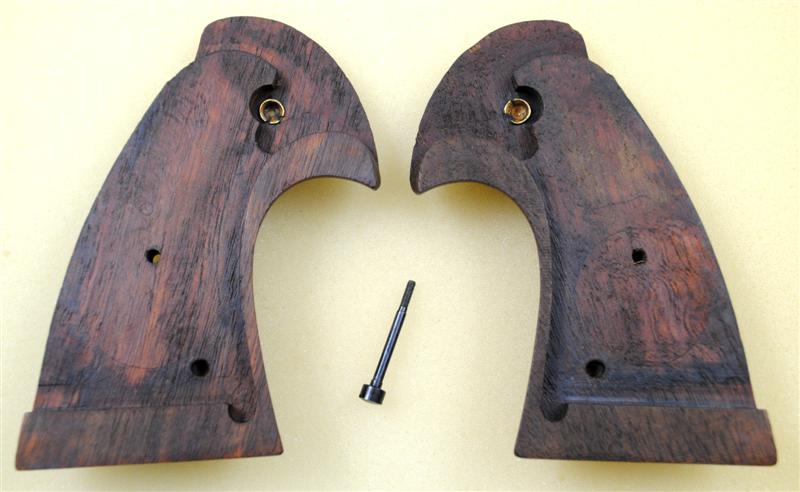
1st gen Python grips, back. The picture shows the early variation with flat back.
Generation 2 (1960 - 1974)
The most distinguishing feature is that the top edge of the checkered area has a curved shape that wraps around the bottom of the medallion, which is why the Gen 2s are sometimes called “smiley face grips”. The backs are cut with fitting pads, which allow for trimming to the thickness of the frame and also provide clearance for the rebound lever pin. The left panel has a thumb cut, sometimes referred to as a speed loader cut.
The majority of these grips are made of walnut, but many of them are very light in color and weight, most likely made of mahogany. Some early grips have an oil finish, but the most common finish is a tinted clear coat. The finish is normally of high quality without much open grain.
The screw heads could be either a polished blue finish or the later “machine finish”. The screws and nuts were nickel plated on nickel plated guns. The medallions were staked like on Gen 1, with either a pyramid shaped or cone shaped tool.
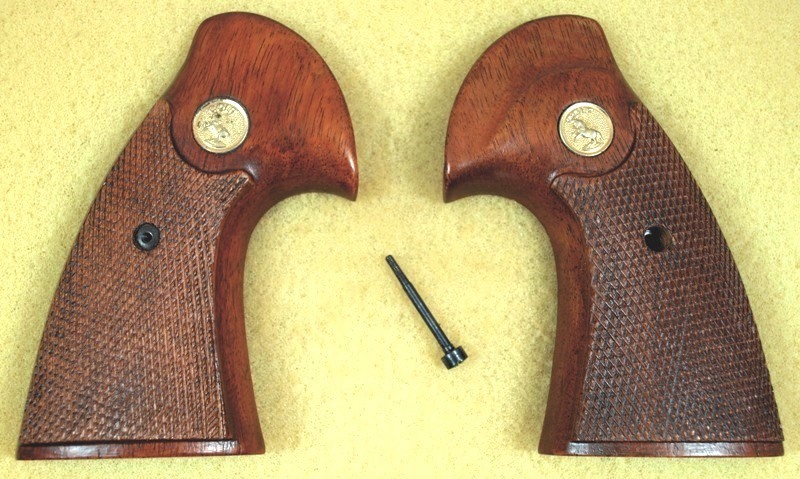
2nd gen Python grips, front. Note how the checkering wraps around the bottoms of the medallions.
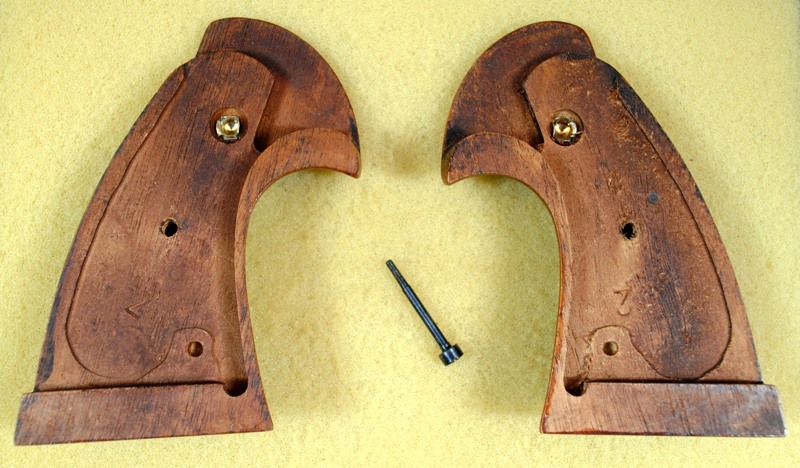
2nd gen Python grips, back. Note the fitting pads along the rear edges and the pin holes.
Transitional variations
The transitional grips can be a bit confusing, as there are two types: transitional Gen 2 and transitional Gen 3. Some like to call these grips “variations” rather than “transitional types”, but the new features were gradually introduced so going from Gen 2 to Gen 3 was more of a gradual transition than an immediate change to an entirely new design.
Transitional Generation 2 (early 1974 only)
These look like Gen 2 grips at first glance, but are symmetrical with thumb cuts on both sides. These were used very briefly, and (strangely) they have the same “fat” cross section and flat back cuts as the Gen 3 introduced in 1979. This variation appears to be identical to Gen 3, but with the “smiley face” checkering like on Gen 2. The wood is normally light in color, and the sanding and finishing usually doesn’t show the same level of craftsmanship as on Gen 2.
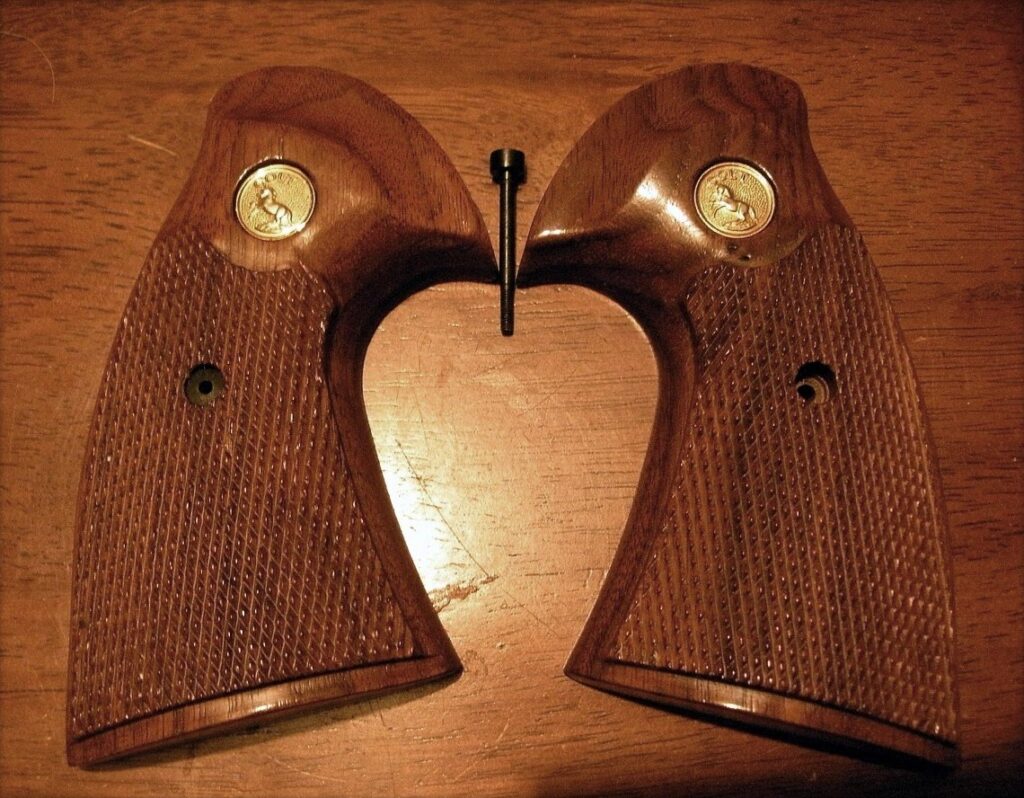
Transitional 2nd Gen Python grips, front. Note the symmetrical panels with thumb cut.
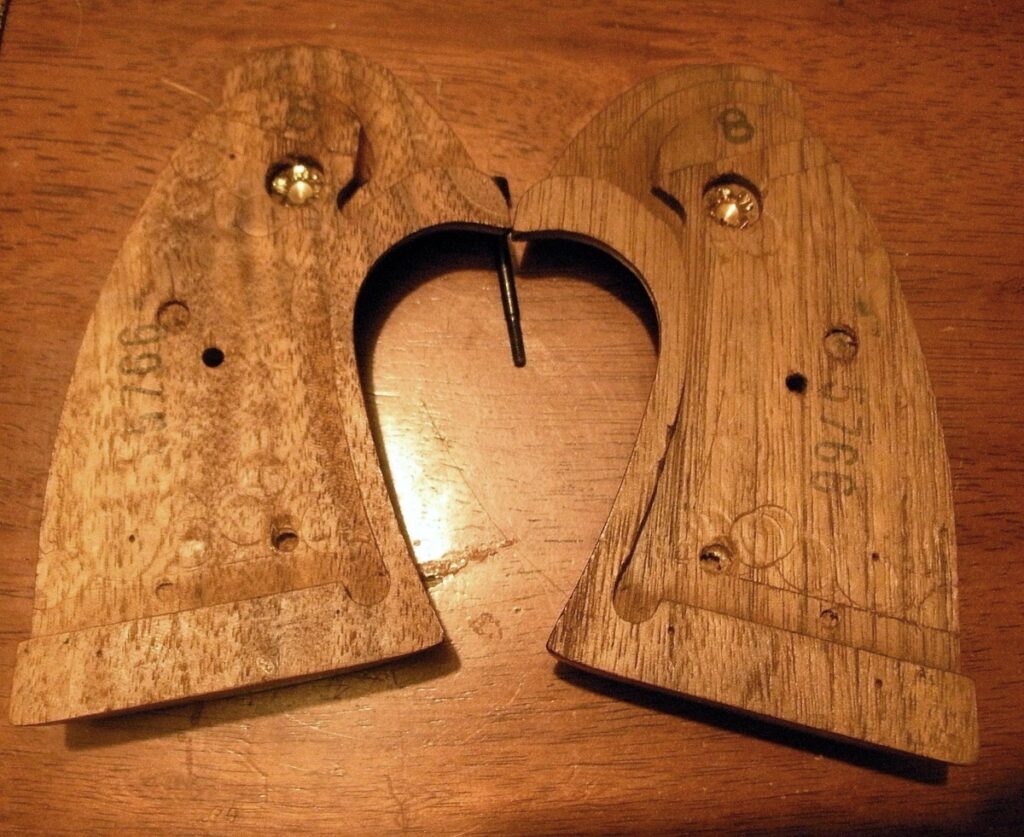
Transitional 2nd Gen Python grips, back. Note the lack of fitting pads, the backs are very similar to late gen 3.
Transitional (or “early”) Genereration 3 (1974-1978)
This variation looks very similar to late Gen 3, but has the early style backs with fitting pads, like on Gen 2. Most early Gen 3 grips we have seen were made of mahogany and sprayed with a dark tint to resemble walnut. They are often confused with the later Gen 3 (or even mistaken for reproductions), but the following details make them easy to recognize:
1: The upper corners of the checkered area are slightly rounded, whereas the late Gen 3 has sharp corners.
2: Seen from the bottom, the cross section is a continuous oval like on Gen 2, whereas the late Gen 3 has a compound curve shape with more or less pronounced corners where the curves meet.
3: The thumb cuts are larger than on late Gen 3, so this variation is sometimes called “large ear grips”. According to some sources, there were similar grips made by an aftermarket company, possibly Jay Scott. These looked like original grips and had original hardware, but they were made of light colored wood. These are easily confused with original grips, and we have observed some of these having a very thin clear coat of poor quality, sometimes deteriorated to the point that it could be easily scraped off with your fingernail.
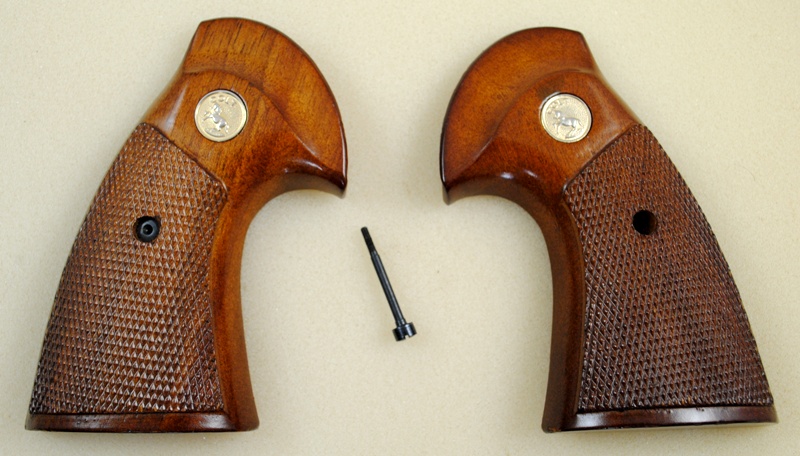
Early 3rd gen Python grips, front. Note the rounded upper corners of the checkering and the large thumb cuts. Also note that the set in the picture has a sharp upper corner, whereas most of them were rounded off.
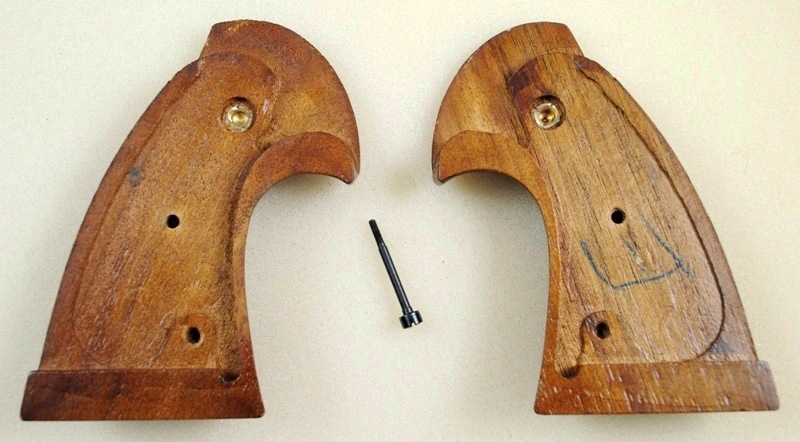
Early 3rd gen Python grips, back. Note that the fitting pads from gen 2 are still present (or rather reintroduced, if you compare with the transitional gen 2). Also note the light colored wood, which is a typical feature of this variation.
Late Generation 3 (1979 - 1985 and 1989 – 1990)
These grips are symmetrical with thumb cuts on both sides, and the checkered area has square corners. The backs are flat without fitting pads, and have circular recesses to clear the pin for the rebound lever. There is also a shallow clearance cut at the top “half moon”. Within this variation, we have observed that the width of the bottom border under the checkered area can vary quite a bit, sometimes to the point of “looking funny”. You will also find some late Gen 3 grips with a somewhat “blocky” look where the rounded surfaces are not blended in properly.
The quality of late Gen 3 grips can vary from perfect to downright pitiful, indicating that the lowest bidding grip manufacturer wasn’t always up to the task. The wood is quite often of lesser quality than in previous generations, and we have even observed sets where one panel was made of walnut and the other one of mahogany. Some have also observed damage and defects being repaired with wood filler. To hide defects and differences in wood quality, the late Gen 3 grips were most often sprayed with a tinted clear coat that made the color more uniform and attractive. Also, the quality of the clear coat will vary from excellent to poor, the sheen can vary from high gloss to satin and it will show more or less open grain. Many times you’ll see signs of poor adhesion, and the clear coat will usually chip or blister if damaged. In some of the poorest examples, you can also find obvious defects in the workmanship, such as rough sanding and medallions installed too deep or crooked. We have even found washers behind the medallions in some grips where the recesses were cut way too deep, so it’s obvious that some manufacturers weren’t too detail oriented.
The screw heads had a blued machine finish. Screws and nuts were normally nickel plated on early nickel plated guns, but some have been observed having blued hardware. The medallions were staked with a cone shaped tool that formed a flare.
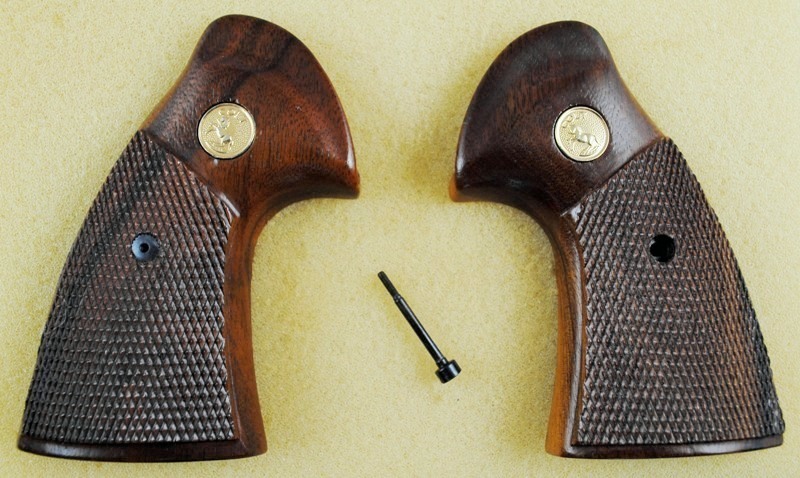
Late 3rd gen Python grips, front. Note the square upper corners of the checkering and the smaller thumb cuts. Also note the somewhat rough finish, which is typical for many of these.
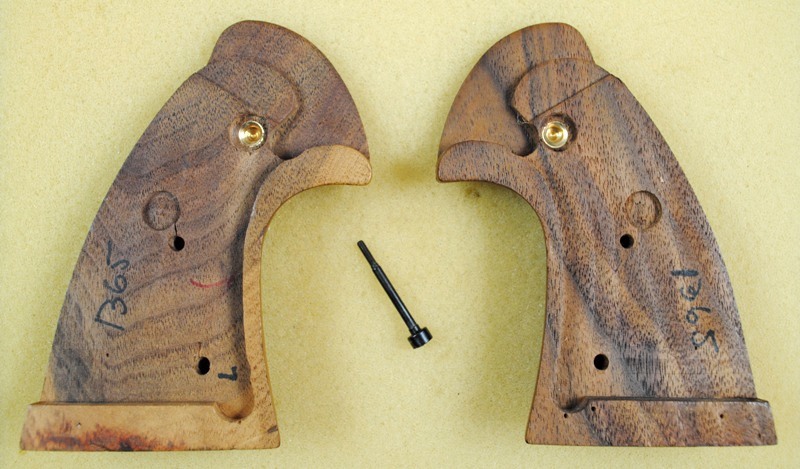
Late 3rd gen Python grips, back. Note the flat backs, the circular relief cuts for the rebound lever pin and the straight relief cut above the medallions. Also note the difference in wood color and grain direction between the panels, which probably explains why this set was sprayed with a heavy coat of tint.
Summary and final notes
As mentioned in the introduction, this is not a definitive guide to all the variations you will encounter. It appears that many subcontractors produced “their best interpretation” of the drawings and/or prototypes provided by Colt, and that Colt accepted the variations resulting from this.
Gen 1, Gen 2 and early Gen 3 are normally quite consistently made, while late Gen 3 can vary widely in appearance, finish and overall quality. We suspect that these variations could be the result of Colt trying out new subcontractors, and some scarce variations could possibly be from smaller test orders. Unfortunately, we do not have any documentation on this, so we can only speculate based on our observations.
It’s obvious that Colt’s quality standards were quite stringent in the beginning of Python production, but declined to “good enough” at the end. As a matter of fact: Some of the late grips are so poorly made that they look totally out of place on a revolver that was supposed to be Colt’s flagship. Colt shouldn’t have had any problems finding quality subcontractors, so the only conclusion we can draw is that the decline in quality was due to cost cutting measures. The result of this is that late Gen 3 grips are very inconsistently made, and this makes them more difficult to identify than the earlier generations.
However, the hardware was always made in a very consistent way, and studying this is normally a foolproof way to identify original grips. The medallions will vary in appearance, but the quality alone is a good way to identify them. Most importantly, the screws were all made to the same exact pattern throughout production, so any deviation should be an immediate red flag. We strongly recommend that you learn what the original hardware should look like, and in our opinion: This should always be the first thing to look at when you’re trying to verify the authenticity of a set of grips!
Last, but not least: Nothing beats hands-on experience. Take every opportunity you get to study original, unaltered grips. Once you have seen enough of them and taken mental notes of their general appearance, you’ll be able to identify most of them at a quick glance. The downside of expensive collectibles is that many sellers are trying to take advantage of uneducated buyers, so don’t be one of them. This is one of the reasons why we have published this guide, and we’re hoping that it will help you avoid costly mistakes!